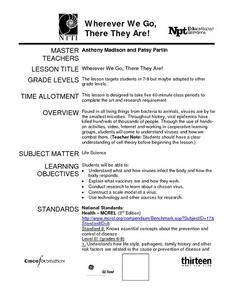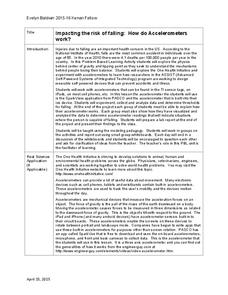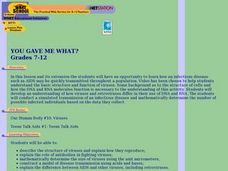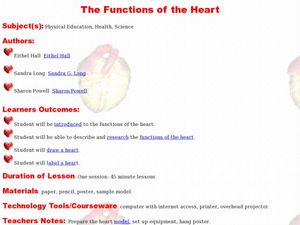Nuffield Foundation
Modelling the Human Ventilation System
Why is breathing so difficult for asthma sufferers? To find out, learners build their own lung models in the investigation (from a British website, hence the term ventilation system instead of respiratory system). Using...
Curated OER
The Incredible, Edible Cell
Students discover organelles and the functions organelles perform in cells. For this biology lesson, students create model cells using Jell-o, then dissect their "cell" to examine the parts that create a cell. Students create a diagram...
Curated OER
Getting Up the Nerve
Students examine the basics of the nervous system through an interactive program. They discover how the brain is linked to muscle movement. They can test cells through the interactive program to see how it reacts to different stimuli.
Curated OER
Wherever We Go, There They Are!
The central video for this lesson is not available through the included resource link. However, the activity that simulates the passing of a virus through a population is impacting and the other resource links are invaluable. Use this...
Children’s Hospital of Philadelphia
The Adaptive Immune System
Attack the pathogen from within. Learners delve deeper into the immune system and find out about the adaptive immune system such as T and B cells. Groups create graphical models of the adaptive immune system along with a multimedia...
NBC
Nutrition, Hydration, and Health
NFL football in science class? Yes, please! In an engaging and motivating three-day lesson, kids take a look at their own nutritional habits and needs compared to those of an NFL player, then experiment with the effects of hydration on...
Curated OER
Obesity
Young scholars examine how hormones affect different tissues. In groups, they make their own hormone-receptor model and identify the characteristics of tissues that respond to the different hormones. To end the lesson plan, they examine...
Curated OER
Ghost in Your Genes
Students explore DNA microarrays. In this genetics lesson plan, students model DNA microarrays that are used by scientists. Students work to determine levels of breast cancer genes in patients. They will determine the treatment required...
Curated OER
PICTURE PERFECT PYRAMID
Learners create a model of the USDA's Food Pyramid Guide, using shoe boxes. They bring an assortment of shoe boxes from home. Students are given a copy of the "Food Guide Pyramid." They wrap boxes for the bread group in white, the...
Curated OER
Tag, You're Sick
Learners play a game to model how the immune system works. In this health and wellness instructional activity, the teacher explains how the immune system works, then students play a game of tag trying to stay away from germs, viruses,...
Curated OER
Cardiac Maze
Students participate in a role-play activity to lean about red and white blood cells, veins, capillaries and arteries. They also see how blood passes through the heart, lungs and out of the body, carrying oxygen and nutrients.
Curated OER
The Challenge to Deliver Insulin
Students study the types of diabetes and why insulin is important. In this diabetes lesson students build molecular models and create a healthy lifestyle plan.
Curated OER
HIV/AIDS, iChat, and the Immune System
Students study HIV and model the course of an infection. In this immune system lesson students examine HIV and AIDS and learn that it is a preventable disease.
Curated OER
Pregnancy, day 1
A health lesson presents all aspects of conception and pregnancy. Fourth through sixth-graders define terms associated with pregnancy, label a chart of a woman, and discuss how pregnancy occurs. Some excellent activities and a wonderful...
Howard Hughes Medical Institute
Virus Explorer
Most pupils know about the flu, HIV, and other viruses, but they don't know what each actually looks like. This interactive shows their relative size, structure, and allows for comparisons. It stresses the similarities and differences...
Kenan Fellows
Impacting the Risk of Falling: How Do Accelerometers Work?
Young engineers consider how to apply accelerometers and sensors to help prevent falls in elderly people. They consider forces of motion and gravity as part of the engineering design process.
Curated OER
Nutrition in Me
Learners discuss and complete activities to further their knowledge about nutrition in their diet. In this nutrition lesson, students discuss their diets and the amount of vegetables and fruits they are consuming daily. Learners...
Curated OER
You Gave Me What?
Students see how an infectious disease such as AIDS may be quickly transmitted throughout a population. They conduct a simulated transmission of an infectious disease and mathematically determine the number of possible infected individuals.
Curated OER
Biomechanics of Sports
Students examine the body's major organ systems and how they function and influence each other. They examine how the human body moves when involved in sports.
Curated OER
Basic Introduction to Foundation of Life: Genes, Genetics and Genetic Diseases
Students are introduced to genetics along with genetic diseases and heredity. In groups, they complete a Punnett Square to determine the dominant and recessive genes. After viewing diagrams, they identify the characteristics of DNA and...
Curated OER
The Functions of the Heart
Students explore the function of the human heart. For this heart anatomy lesson, students participate in activities offered at an Internet website to discover the characteristics and jobs of the parts of the human heart.
Curated OER
The Challenge to Deliver Insulin
Students investigate these fundamental chemical and cellular processes. They recognize the long-term danger that comes from a diet of fast food, chips, and soda, realize that avoiding diabetes is their responsibility, and establish...
Curated OER
Reproduction, Day 1
Students identify the parts of the human body involved in reproduction. They examine the process of fertilization and discover all species reproduce. They practice using new vocabulary as well.
Curated OER
Walk Around the Block
Second graders participate in walking a route in a neighborhood with parent volunteers in order to stress the importance of looking and listening for moving cars. They take this "field trip
Other popular searches
- 3d Animal Cell Models
- Cells Models Cytoskeleton
- Animal Cell Models
- Models of Cells
- Cells Models Deescalating























